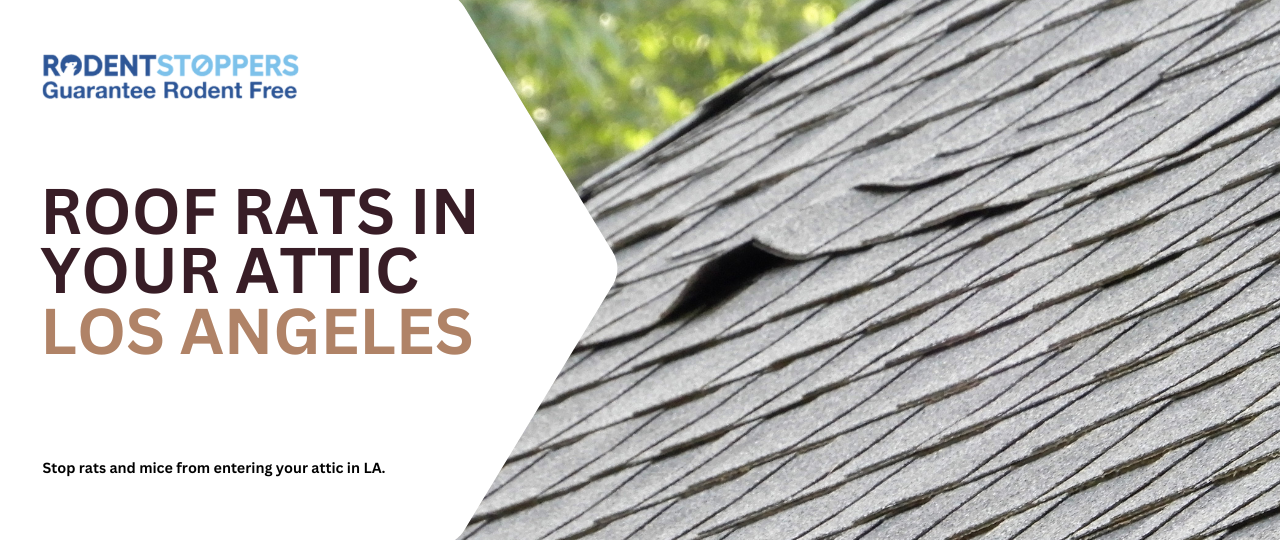
Roof rats are a pervasive problem in Los Angeles, taking full advantage of the city’s warm climate, dense urban environment, and common architectural features. Their ability to climb and infiltrate elevated spaces makes attics and roof vents their primary target. Once inside, roof rats can cause extensive structural damage, contaminate homes, and pose significant health risks. For homeowners, understanding the dangers of roof rats and how to prevent infestations is crucial to protecting their property.
Why Roof Rats Target Los Angeles Homes
Roof rats thrive in environments that provide easy access to food, water, and shelter—all of which are abundant in Los Angeles. The city’s mild climate allows roof rats to remain active and breed year-round, giving them a significant advantage over other rodent species. Additionally, the abundance of shade trees, climbing vines, and utility lines provides convenient pathways for roof rats to reach rooftops. Many Los Angeles homes feature shingle roofs, unsealed roof vents, and gaps in eaves or soffits, all of which serve as entry points for these agile rodents.
Los Angeles homes feature a diverse range of roof structures, each with its own aesthetic and functional advantages, but many of these designs also present vulnerabilities that roof rats can easily exploit. Shingle roofs, one of the most common types in LA, are prone to gaps and loose tiles over time, especially due to weathering, making them an accessible entry point for roof rats. These small gaps allow rats to squeeze through and access attics or crawl spaces. Similarly, Spanish-style clay tile roofs, iconic in many Los Angeles neighborhoods, create hidden voids and overlaps under the tiles where rats can nest. The curved design of clay tiles provides natural hiding spots, and any loose or broken tiles make it easy for rodents to infiltrate a home.
Flat roofs, often found on mid-century modern homes and commercial buildings, are another target for roof rats. These roofs typically have external HVAC systems, vents, and drainage pipes that can become weak points if not properly sealed. The flat surface can also collect debris and standing water, attracting rats seeking food, water, and nesting materials. Metal roofs, though less common in residential areas, are not immune to rodent activity; gaps between metal sheets or poorly sealed flashing can serve as entry points. Additionally, many Los Angeles homes have vented eaves and soffits, which, if not equipped with rodent-proof screens, provide rats with direct access to attic spaces.
Overhanging trees and climbing vines, which are often part of Los Angeles’ lush landscaping, further exacerbate the issue by acting as bridges that lead directly to roofs. Roof rats use their remarkable climbing abilities to traverse these pathways, making even well-maintained roofs susceptible to infestations. Once inside, they exploit the warmth, darkness, and safety of attics to build nests, breed, and chew on electrical wiring, insulation, and wooden beams. Regular inspections, maintenance, and proper sealing of these structural features are essential to prevent roof rats from exploiting these vulnerabilities and causing significant damage to Los Angeles homes.
How Roof Rats Enter Attics and Roof Vents
Roof rats are incredibly skilled climbers and can scale walls, trees, and cables with ease. In Los Angeles, where many homes are surrounded by mature trees and landscaping, overhanging branches allow roof rats to access roofs directly. Once on the roof, they exploit any weaknesses, such as cracked tiles, damaged vent screens, or poorly sealed chimneys, to gain entry. Attics provide the perfect environment for roof rats: dark, warm, and largely undisturbed, making them an ideal nesting and breeding ground.
The Structural Damage Caused by Roof Rats
Once inside, roof rats cause significant structural damage. They gnaw constantly to keep their teeth from overgrowing, which often results in chewed wires, shredded insulation, and damaged wooden beams. Chewed electrical wiring not only compromises the functionality of your home but also poses a serious fire hazard. Insulation contaminated by droppings and urine becomes ineffective and may need to be completely replaced. Over time, the cumulative damage can lead to costly repairs and reduced property value.
Health Risks Associated with Roof Rats
Roof rats are not just a structural threat—they also pose serious health risks to homeowners. These rodents are carriers of dangerous diseases, including Salmonella, Leptospirosis, and Hantavirus. Their droppings, urine, and nesting materials can contaminate insulation, air ducts, and surfaces, spreading harmful pathogens throughout the home. Inhaling dust particles from dried rodent waste can exacerbate respiratory conditions and allergies. Moreover, roof rats often bring parasites like fleas and ticks into homes, increasing the risk of secondary infestations.
Why Roof Rats Breed Rapidly in Los Angeles
The warm climate of Los Angeles provides ideal conditions for roof rats to breed continuously throughout the year. A single pair of roof rats can produce multiple litters annually, with each litter containing six to eight offspring. In the safety of attics and other elevated spaces, roof rats can quickly establish large populations. Without immediate intervention, a small infestation can escalate into a major problem, with rodents spreading to other parts of the home.

Signs of a Roof Rat Infestation
Homeowners should be vigilant for signs of roof rat activity, especially in attics and roofs. Common indicators include:
- Scratching Noises: Sounds of scurrying or scratching in walls and ceilings, particularly at night.
- Droppings: Small, dark, spindle-shaped droppings near entry points or along rodent pathways.
- Gnaw Marks: Chewed wires, wood, or plastic in attics and crawl spaces.
- Nesting Materials: Shredded paper, insulation, or fabric in undisturbed areas.
- Odors: A strong, musky smell from droppings, urine, or decaying rodents.
Preventing Roof Rat Infestations in Los Angeles
Taking proactive measures can significantly reduce the risk of roof rats invading your home. Start by sealing all potential entry points, including cracks in roofs, damaged vents, and gaps in soffits or eaves. Install rodent-proof vent covers and chimney caps to block common access routes. Regularly trim tree branches and vines that overhang your roof, as these act as pathways for rodents. Additionally, secure trash bins with tight-fitting lids and avoid leaving pet food or birdseed outdoors.
Why Professional Intervention Is Key
DIY methods are often insufficient when dealing with roof rats, especially in areas as prone to infestations as Los Angeles. Professional rodent control services can provide a comprehensive solution, from identifying entry points and vulnerabilities to setting up effective traps and implementing long-term prevention strategies. High-quality traps like the Twin Traps or the Rat Vac are designed specifically for difficult-to-reach areas like attics, ensuring quick and humane removal of roof rats.
The Long-Term Impact of Roof Rat Infestations
Ignoring a roof rat infestation can lead to long-term consequences, including recurring infestations, ongoing structural damage, and persistent health hazards. The costs of neglecting the problem often far outweigh the expense of professional rodent control services. By addressing the issue early and implementing robust prevention measures, homeowners can protect their property, health, and peace of mind.
Conclusion
Roof rats pose a significant threat to Los Angeles homeowners, particularly in attics and roof spaces. Their agility, rapid breeding cycle, and ability to exploit common architectural vulnerabilities make them a persistent problem. By understanding their habits and taking proactive steps to secure your home, you can reduce the risk of infestations. For comprehensive and reliable solutions, trust professional rodent control services to eliminate roof rats and protect your home for the long term. Don’t wait until the problem escalates—take action today to safeguard your home from the hidden dangers of roof rats.

